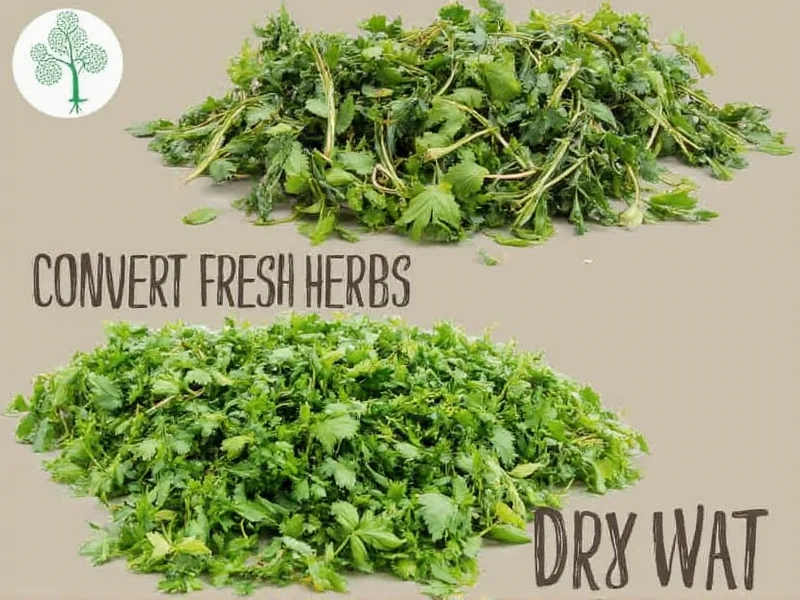Converting fresh herbs to dried form extends their shelf life while preserving essential flavors for cooking. Whether you've harvested from your garden or bought in bulk, proper drying techniques maintain potency and prevent spoilage. This guide covers scientifically validated methods, precise conversion measurements, and storage protocols used by professional chefs.
Why Proper Herb Conversion Matters
Incorrect fresh-to-dried ratios cause inconsistent seasoning—the most common kitchen mistake with dried herbs. Fresh herbs contain 80-90% water, which evaporates during drying, concentrating flavors. Understanding exact conversion prevents bitter or weak-tasting dishes. Culinary professionals rely on standardized measurements to maintain recipe consistency across seasons.
Drying Methods Compared
| Method | Time Required | Best For | Flavor Retention |
|---|---|---|---|
| Air Drying | 1-3 weeks | Hardy herbs (rosemary, thyme, oregano) | 85-90% |
| Oven Drying | 2-4 hours | Emergency drying | 75-80% |
| Dehydrator | 4-8 hours | All herb types | 90-95% |
| Freeze Drying | 24-48 hours | Commercial use | 95-98% |
Step-by-Step Drying Process
Preparation Essentials
Harvest herbs in morning after dew evaporates but before sun intensifies. Use sharp scissors to avoid bruising stems. Gently rinse only if necessary—excess moisture prolongs drying. Pat completely dry with linen towels. Never use wilted or damaged leaves.
Air Drying Technique
Bundle 5-6 stems with twine, securing stems without crushing. Hang upside down in dark, well-ventilated space at 60-70°F (15-21°C) with 60% humidity. Cover loosely with paper bags to prevent dust accumulation while allowing airflow. Check daily—herbs are ready when leaves crumble easily (usually 10-14 days).
Dehydrator Method
Set temperature to 95°F (35°C). Arrange single herb layers on trays without overlapping. Rotate trays hourly for even drying. Most herbs finish in 4-8 hours. Test readiness by crushing a leaf—it should disintegrate immediately without bending.
Exact Fresh-to-Dried Conversion Chart
While the standard 3:1 ratio applies generally, specific herbs require adjustments due to varying moisture content and oil concentration:
| Herb Type | Fresh Measurement | Dried Equivalent | Special Notes |
|---|---|---|---|
| Basil | 3 Tbsp chopped | 1 Tbsp dried | Add dried basil early in cooking |
| Cilantro | 4 Tbsp chopped | 1 Tbsp dried | Loses flavor quickly when dried |
| Mint | 3.5 Tbsp chopped | 1 Tbsp dried | Stronger dried than fresh |
| Parsley | 3 Tbsp chopped | 1 Tbsp dried | Retains color well |
| Rosemary | 2.5 Tbsp chopped | 1 Tbsp dried | More concentrated when dried |
Proper Storage for Maximum Shelf Life
Store completely cooled dried herbs in airtight glass containers away from light and heat. Include silica gel packets to absorb residual moisture. Label with harvest date—properly stored dried herbs maintain peak flavor for 6-12 months. Test potency by rubbing between fingers; strong aroma indicates freshness. Discard if color fades significantly or aroma diminishes.
Avoiding Common Drying Mistakes
Never dry herbs in direct sunlight—UV rays degrade essential oils. Avoid high-heat oven methods above 180°F (82°C) which cook rather than dry herbs. Don't skip the curing phase—allow 2 weeks in storage before use for optimal flavor development. Never store dried herbs near stoves or windows where temperature fluctuates.
Culinary Application Guidelines
Add dried herbs earlier in cooking than fresh to allow rehydration and flavor release. Compensate for intensified flavors by starting with 1/3 the amount you'd use fresh, then adjust to taste. Reconstitute dried herbs by soaking in warm broth or wine for 10 minutes before adding to dishes. Remember that dried delicate herbs like dill and tarragon lose significant flavor—fresh versions work better for these varieties.
What's the most accurate way to measure dried herbs?
Use weight measurements for precision—1 ounce fresh herbs typically yields 0.33 ounces dried. For volume measurements, lightly pack dried herbs without compressing. Always measure after drying, as compression during storage alters volume.
Can I dry herbs in the microwave?
Microwave drying works for small batches but risks uneven results. Place herbs between paper towels, microwave 30 seconds at 20% power, then check. Repeat in 15-second intervals until brittle. This method achieves only 70-75% flavor retention compared to dehydrators.
Why do some dried herbs taste bitter?
Bitterness occurs from overheating during drying or improper storage. Herbs dried above 100°F (38°C) develop bitter compounds. Exposure to light degrades chlorophyll into bitter substances. Always use low-temperature methods and opaque storage containers.
How do I know when herbs are fully dried?
Properly dried herbs should crumble instantly when pressed between fingers. Stems should snap cleanly rather than bend. Perform the 'fold test' with leaves—they should break rather than crease. Any moisture retention causes mold during storage.











 浙公网安备
33010002000092号
浙公网安备
33010002000092号 浙B2-20120091-4
浙B2-20120091-4